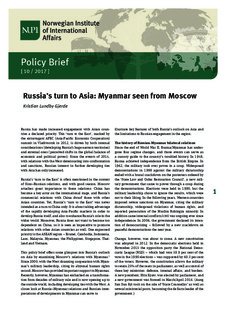| dc.contributor.author | Gjerde, Kristian Lundby | |
| dc.date.accessioned | 2017-08-29T09:33:26Z | |
| dc.date.available | 2017-08-29T09:33:26Z | |
| dc.date.created | 2017-08-17T13:14:31Z | |
| dc.date.issued | 2017 | |
| dc.identifier.uri | http://hdl.handle.net/11250/2452187 | |
| dc.description.abstract | Russia has made increased engagement with Asian countries
a declared priority. This ‘turn to the East’, marked by
the extravagant APEC (Asia-Pacific Economic Cooperation)
summit in Vladivostok in 2012, is driven by both internal
considerations (developing Russia’s huge eastern territories)
and external ones (perceived shifts in the global balance of
economic and political power). Since the events of 2014,
with relations with the West deteriorating into confrontation
and sanctions, Russian interest in further developing ties
with Asia has only increased. | nb_NO |
| dc.language.iso | eng | nb_NO |
| dc.publisher | Norsk utenrikspolitisk institutt | nb_NO |
| dc.relation.ispartof | NUPI Policy Brief | |
| dc.relation.ispartofseries | NUPI Policy Brief;2017-10 | |
| dc.rights | Navngivelse-Ikkekommersiell-DelPåSammeVilkår 4.0 Internasjonal | * |
| dc.rights.uri | http://creativecommons.org/licenses/by-nc-sa/4.0/deed.no | * |
| dc.title | Russia’s turn to Asia: Myanmar seen from Moscow | nb_NO |
| dc.type | Research report | nb_NO |
| dc.description.version | publishedVersion | nb_NO |
| dc.source.pagenumber | 4 | nb_NO |
| dc.source.issue | 10 | nb_NO |
| dc.identifier.cristin | 1486946 | |
| cristin.unitcode | 7471,11,0,0 | |
| cristin.unitname | Russland, Eurasia og Arktis | |
| cristin.ispublished | true | |
| cristin.fulltext | original | |

